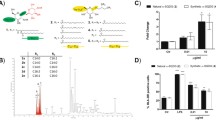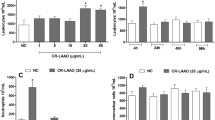Abstract
We evaluated tumor cell growth modulation by bee venom secretory phospholipase A2 (bv-sPLA2) and phosphatidylinositol-(3,4)-bisphosphate as well as potential cooperative effects. In addition, the immunomodulatory impact of tumor cell treatment was examined by monitoring changes in phenotype and function of monocyte-derived dendritic cells (moDCs) cocultured with pretreated tumor cells. Bv-sPLA2 or phosphatidylinositol-(3,4)-bisphosphate alone displayed moderate effects on the proliferation of A498 renal cell carcinoma cells, T-47D breast cancer cells, DU145 prostate cancer cells and BEAS-2B transformed lung cells. However, when bv-sPLA2 was coadministered with phosphatidylinositol-(3,4)-bisphosphate a potent inhibition of [3H] thymidine incorporation into all tested cell lines occurred. This inhibition was due to massive cell lysis that reduced the number of cells with proliferative capacity. Importantly, tumor cell lysates generated with bv-sPLA2 plus phosphatidylinositol-(3,4)-bisphosphate induced maturation of human moDCs demonstrated by enhanced expression of CD83 and improved stimulation in allogeneic mixed leukocyte reactions. Our data demonstrate that bv-sPLA2 and phosphatidylinositol-(3,4)-bisphosphate synergistically generate tumor lysates which enhance the maturation of immunostimulatory human monocyte-derived dendritic cells. Such tumor lysates which represent complex mixtures of tumor antigens and simultaneously display potent adjuvant properties meet all requirements of a tumor vaccine.






Similar content being viewed by others

References
Andreae S, Buisson S, Triebel F (2003) MHC class II signal transduction in human dendritic cells induced by a natural ligand, the LAG-3 protein (CD223). Blood 102:2130–2137
Appel S, Rupf A, Weck MM, Schoor O, Brummendorf TH, Weinschenk T, Grunebach F, Brossart P (2005) Effects of imatinib on monocyte-derived dendritic cells are mediated by inhibition of nuclear factor-kappaB and Akt signaling pathways. Clin Cancer Res 11:1928–1940
Ashagbley A, Samadder P, Bittman R, Erukulla RK, Byun HS, Arthur G (1996) Synthesis of ether-linked analogues of lysophosphatidate and their effect on the proliferation of human epithelial cancer cells in vitro. Anticancer Res 16:1813–1818
Babon A, Almunia C, Boccaccio C, Beaumelle B, Gelb MH, Menez A, Maillere B, Abastado JP, Salcedo M, Gillet D (2005) Cross-presentation of a CMV pp65 epitope by human dendritic cells using bee venom PLA2 as a membrane-binding vector. FEBS Lett 579:1658–1664
Balsinde J, Dennis EA (1997) Function and inhibition of intracellular calcium-independent phospholipase A2. J Biol Chem 272:16069–16072
Banchereau J, Steinman RM (1998) Dendritic cells and the control of immunity. Nature 392:245–252
den Brok MH, Nierkens S, Figdor CG, Ruers TJ, Adema GJ (2005) Dendritic cells: tools and targets for antitumor vaccination. Expert Rev Vaccines 4:699–710
Cox JC, Coulter AR (1997) Adjuvants—a classification and review of their modes of action. Vaccine 15:248–256
Del Prete A, Vermi W, Dander E, Otero K, Barberis L, Luini W, Bernasconi S, Sironi M, Santoro A, Garlanda C, Facchetti F, Wymann MP, Vecchi A, Hirsch E, Mantovani A, Sozzani S (2004) Defective dendritic cell migration and activation of adaptive immunity in PI3Kgamma-deficient mice. Embo J 23:3505–3515
Dennis EA (1994) Diversity of group types, regulation, and function of phospholipase A2. J Biol Chem 269:13057–13060
Fogh J, Fogh JM, Orfeo T (1977) One hundred and twenty-seven cultured human tumor cell lines producing tumors in nude mice. J Natl Cancer Inst 59:221–226
Gallucci S, Matzinger P (2001) Danger signals: SOS to the immune system. Curr Opin Immunol 13:114–119
Gille H, Downward J (1999) Multiple ras effector pathways contribute to G(1) cell cycle progression. J Biol Chem 274:22033–22040
Grunebach F, Muller MR, Nencioni A, Brossart P (2003) Delivery of tumor-derived RNA for the induction of cytotoxic T-lymphocytes. Gene Ther 10:367–374
Grunebach F, Muller MR, Brossart P (2005) New developments in dendritic cell-based vaccinations: RNA translated into clinics. Cancer Immunol Immunother 54:517–525
Höltl L, Rieser C, Papesh C, Ramoner R, Bartsch G, Thurnher M (1998) CD83+ blood dendritic cells as a vaccine for immunotherapy of metastatic renal-cell cancer. Lancet 352:1358
Höltl L, Rieser C, Papesh C, Ramoner R, Herold M, Klocker H, Radmayr C, Stenzl A, Bartsch G, Thurnher M (1999) Cellular and humoral immune responses in patients with metastatic renal cell carcinoma after vaccination with antigen pulsed dendritic cells. J Urol 161:777–782
Höltl L, Zelle-Rieser C, Gander H, Papesh C, Ramoner R, Bartsch G, Rogatsch H, Barsoum AL, Coggin JH, Thurnher M (2002) Immunotherapy of metastatic renal cell carcinoma with tumor lysate-pulsed autologous dendritic cells. Clin Cancer Res 8:3369–3376
Höltl L, Ramoner R, Zelle-Rieser C, Gander H, Putz T, Papesh C, Nussbaumer W, Falkensammer C, Bartsch G, Thurnher M (2004) Allogeneic dendritic cell vaccination against metastatic renal cell carcinoma with or without cyclophosphamide. Cancer Immunol Immunother 54:663–670
Hsieh CC, Yen MH, Liu HW, Lau YT (2000) Lysophosphatidylcholine induces apoptotic and non-apoptotic death in vascular smooth muscle cells: in comparison with oxidized LDL. Atherosclerosis 151:481–491
Johrer K, Zelle-Rieser C, Perathoner A, Moser P, Hager M, Ramoner R, Gander H, Holtl L, Bartsch G, Greil R, Thurnher M (2005) Up-regulation of functional chemokine receptor CCR3 in human renal cell carcinoma. Clin Cancer Res 11:2459–2465
Kennedy SG, Wagner AJ, Conzen SD, Jordan J, Bellacosa A, Tsichlis PN, Hay N (1997) The PI 3-kinase/Akt signaling pathway delivers an anti-apoptotic signal. Genes Dev 11:701–713
Keydar I, Chen L, Karby S, Weiss FR, Delarea J, Radu M, Chaitcik S, Brenner HJ (1979) Establishment and characterization of a cell line of human breast carcinoma origin. Eur J Cancer 15:659–670
Lechner JF, LaVeck MA (1985) A serum-free method for culturing normal human bronchial epithelial cells at clonal density. J Tissue Cult Methods 9:43–48
Leitinger N (2003) Oxidized phospholipids as modulators of inflammation in atherosclerosis. Curr Opin Lipidol 14:421–430
Matzinger P (2002) The danger model: a renewed sense of self. Science 296:301–305
Mosior M, Six DA, Dennis EA (1998) Group IV cytosolic phospholipase A2 binds with high affinity and specificity to phosphatidylinositol 4,5-bisphosphate resulting in dramatic increases in activity. J Biol Chem 273:2184–2191
Murakami M, Kuwata H, Amakasu Y, Shimbara S, Nakatani Y, Atsumi G, Kudo I (1997) Prostaglandin E2 amplifies cytosolic phospholipase A2- and cyclooxygenase-2-dependent delayed prostaglandin E2 generation in mouse osteoblastic cells. Enhancement by secretory phospholipase A2. J Biol Chem 272:19891–19897
Murakami M, Nakatani Y, Atsumi G, Inoue K, Kudo I (1997) Regulatory functions of phospholipase A2. Crit Rev Immunol 17:225–283
Nakashima S, Ikeno Y, Yokoyama T, Kuwana M, Bolchi A, Ottonello S, Kitamoto K, Arioka M (2003) Secretory phospholipases A2 induce neurite outgrowth in PC12 cells. Biochem J 376:655–666
Nakashima S, Kitamoto K, Arioka M (2004) The catalytic activity, but not receptor binding, of sPLA(2)s plays a critical role for neurite outgrowth induction in PC12 cells. Brain Res 1015:207–211
Noseda A, White JG, Godwin PL, Jerome WG, Modest EJ (1989) Membrane damage in leukemic cells induced by ether and ester lipids: an electron microscopic study. Exp Mol Pathol 50:69–83
Ohara Y, Peterson TE, Zheng B, Kuo JF, Harrison DG (1994) Lysophosphatidylcholine increases vascular superoxide anion production via protein kinase C activation. Arterioscler Thromb 14:1007–1013
Payrastre B, Missy K, Giuriato S, Bodin S, Plantavid M, Gratacap M (2001) Phosphoinositides: key players in cell signalling, in time and space. Cell Signal 13:377–387
Perrin-Cocon L, Agaugue S, Coutant F, Masurel A, Bezzine S, Lambeau G, Andre P, Lotteau V (2004) Secretory phospholipase A2 induces dendritic cell maturation. Eur J Immunol 34:2293–2302
Putz T, Gander H, Ramoner R, Zelle-Rieser C, Rahm A, Nussbaumer W, Bartsch G, Höltl L, Thurnher M (2004) Generation of clinical grade monocyte-derived dendritic cells using the CliniMACS system. Methods Mol Med 24:653–663
Quinn MT, Parthasarathy S, Steinberg D (1988) Lysophosphatidylcholine: a chemotactic factor for human monocytes and its potential role in atherogenesis. Proc Natl Acad Sci USA 85:2805–2809
Ramoner R, Putz T, Gander H, Rahm A, Bartsch G, Schaber C, Thurnher M (2005) Dendritic cell activation by secretory phospholipase A2. Blood 105:3583–3587
Rieser C, Bock G, Klocker H, Bartsch G, Thurnher M (1997) Prostaglandin E2 and tumor necrosis factor alpha cooperate to activate human dendritic cells: synergistic activation of interleukin 12 production. J Exp Med 186:1603–1608
Rizzo MT, Nguyen E, Aldo-Benson M, Lambeau G (2000) Secreted phospholipase A(2) induces vascular endothelial cell migration. Blood 96:3809–3815
Ruiter GA, Verheij M, Zerp SF, van Blitterswijk WJ (2001) Alkyl-lysophospholipids as anticancer agents and enhancers of radiation-induced apoptosis. Int J Radiat Oncol Biol Phys 49:415–419
Samadder P, Bittman R, Byun HS, Arthur G (2004) Synthesis and use of novel ether phospholipid enantiomers to probe the molecular basis of the antitumor Effects of alkyllysophospholipids: correlation of differential activation of c-Jun NH(2)-terminal protein kinase with antiproliferative effects in neuronal tumor cells. J Med Chem 47:2710–2713
Sauter B, Albert ML, Francisco L, Larsson M, Somersan S, Bhardwaj N (2000) Consequences of cell death: exposure to necrotic tumor cells, but not primary tissue cells or apoptotic cells, induces the maturation of immunostimulatory dendritic cells. J Exp Med 191:423–434
Schuler G, Schuler-Thurner B, Steinman RM (2003) The use of dendritic cells in cancer immunotherapy. Curr Opin Immunol 15:138–147
Six DA, Dennis EA (2000) The expanding superfamily of phospholipase A(2) enzymes: classification and characterization. Biochim Biophys Acta 1488:1–19
Stoll LL, Spector AA (1993) Lysophosphatidylcholine causes cGMP-dependent verapamil-sensitive Ca2+ influx in vascular smooth muscle cells. Am J Physiol 264:C885–C893
Stone KR, Mickey DD, Wunderli H, Mickey GH, Paulson DF (1978) Isolation of a human prostate carcinoma cell line (DU 145). Int J Cancer 21:274–281
Toker A (2002) Phosphoinositides and signal transduction. Cell Mol Life Sci 59:761–779
Valentin E, Lambeau G (2000) What can venom phospholipases A(2) tell us about the functional diversity of mammalian secreted phospholipases A(2)? Biochimie 82:815–831
Vanhaesebroeck B, Leevers SJ, Ahmadi K, Timms J, Katso R, Driscoll PC, Woscholski R, Parker PJ, Waterfield MD (2001) Synthesis and function of 3-phosphorylated inositol lipids. Annu Rev Biochem 70:535–602
Weltzien HU, Richter G, Ferber E (1979) Detergent properties of water-soluble choline phosphatides. Selective solubilization of acyl-CoA:lysolecithin acyltransferase from thymocyte plasma membranes. J Biol Chem 254:3652–3657
Wierecky J, Mueller M, Brossart P (2005) Dendritic cell-based cancer immunotherapy targeting MUC-1. Cancer Immunol Immunother (in press)
Acknowledgment
This work was supported by a grant to MT of the kompetenzzentrum medizin tirol (kmt), a center of excellence.
Author information
Authors and Affiliations
Corresponding author
Rights and permissions
About this article
Cite this article
Putz, T., Ramoner, R., Gander, H. et al. Antitumor action and immune activation through cooperation of bee venom secretory phospholipase A2 and phosphatidylinositol-(3,4)-bisphosphate. Cancer Immunol Immunother 55, 1374–1383 (2006). https://doi.org/10.1007/s00262-006-0143-9
Received:
Accepted:
Published:
Issue Date:
DOI: https://doi.org/10.1007/s00262-006-0143-9



